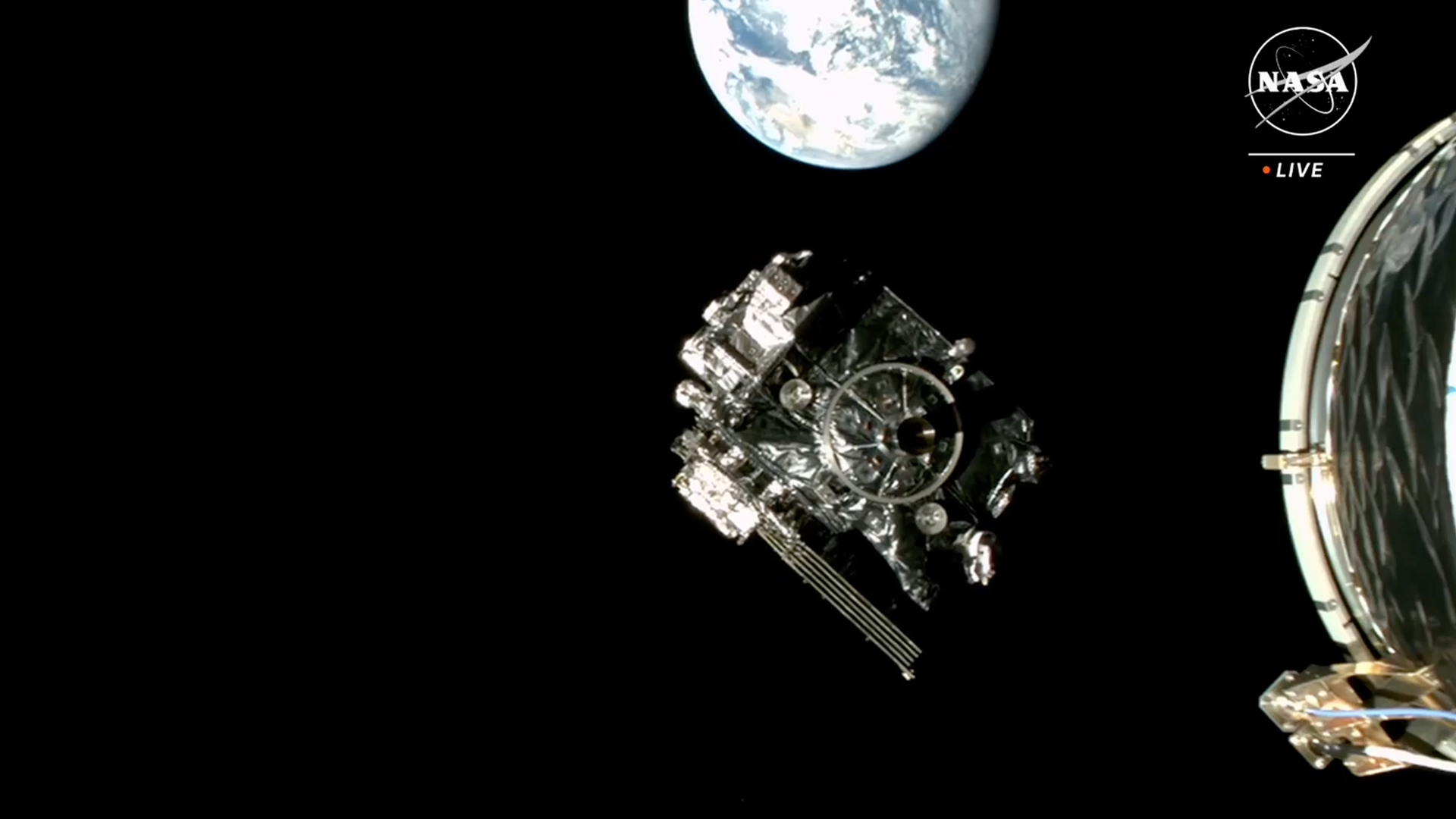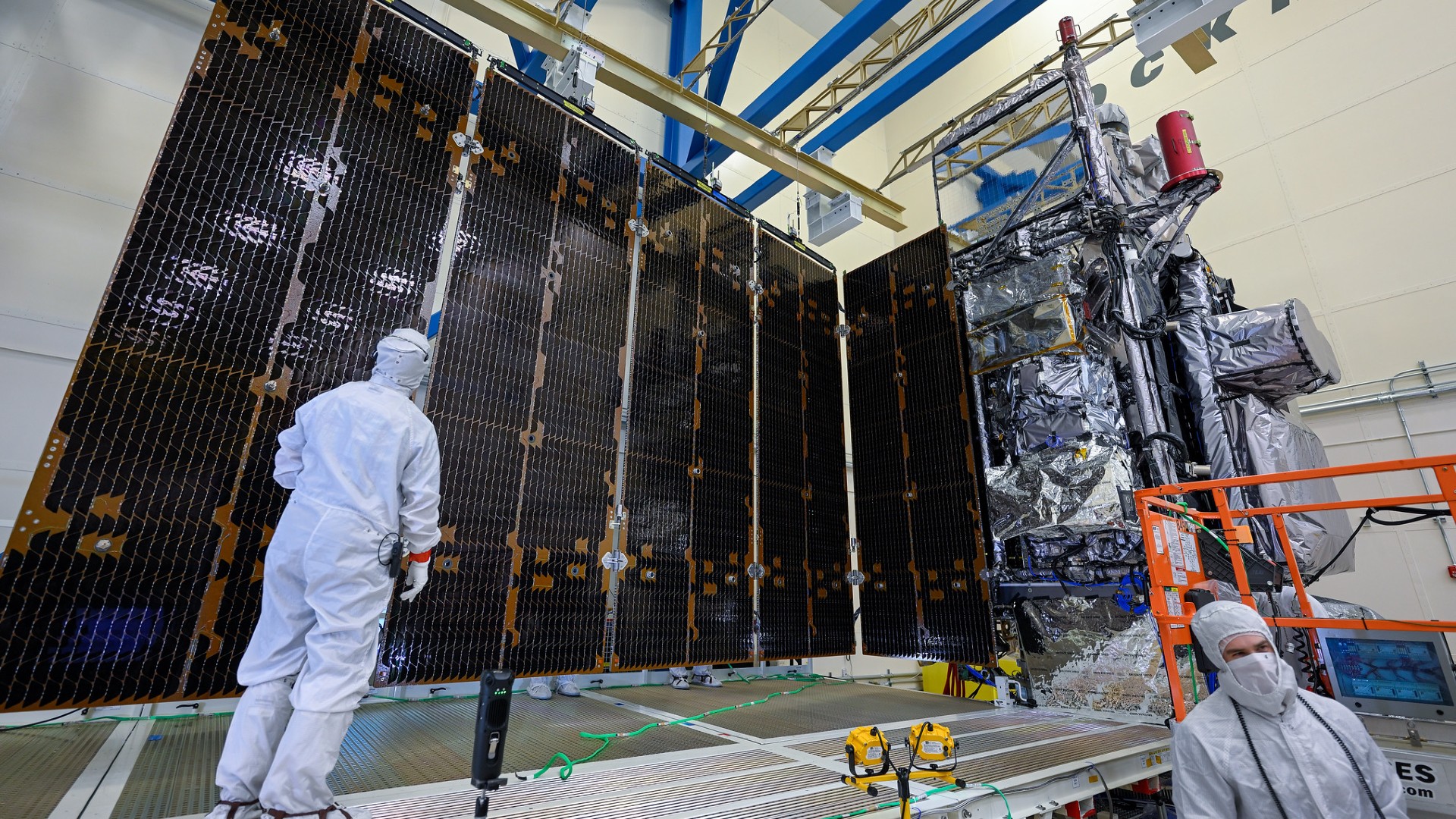Watch GOES-U weather satellite float above a brightly shining Earth in stunning video from space
A spectacular video offers us a front-row seat as SpaceX's Falcon Heavy second stage deploys the powerful GOES-U satellite into space as Earth glows in the background.
The launch of NOAA's powerful new GOES-U weather satellite did not disappoint.
The satellite took off on Tuesday (June 25) atop a SpaceX Falcon Heavy rocket in a picture-perfect launch under a clear blue sky at Launch Complex 39A at NASA's Kennedy Space Center in Florida. The launch marked the 10th launch of Falcon Heavy, and lofted the fourth and final member of the U.S. National Oceanic and Atmospheric Administration's (NOAA) GOES-R series of weather spacecraft.
Four and a half hours after take off, Falcon Heavy's second stage deployed GOES-U into space as Earth shined brightly in the background. The bus-sized spacecraft can be seen floating serenely away, ready to join its place alongside the other GOES satellites in geostationary orbit (GEO) above the Western Hemisphere.

GOES-U will be much more powerful than previous GOES satellites, with five times the imaging speed as its older siblings and four times the image quality. It will also feature a new sensor known as the Geostationary Lightning Mapper (GLM), which will allow scientists to view lightning strikes 24 hours a day.
Lockheed Martin, the aerospace manufacturer that built the satellite, celebrated the deployment in a statement that underscores the value the GOES-R constellation brings to people on the ground every day.
"The launch of GOES-U is the culmination of more than 16 years of designing, building and launching four important weather satellites for our nation," said Jagdeep Shergill, GOES-U program manager at Lockheed Martin. "Since the launch of the first GOES-R satellite, our nation has had more accurate weather forecasts and more timely severe storm warnings, and this critical service has positively affected everyone in the U.S."

The satellite won't only be monitoring weather on Earth, however; GOES-U is equipped with a new instrument known as a Compact Coronagraph (CCOR) that will help it monitor space weather outside of Earth's atmosphere, keeping an eye on solar events that could impact our planet.
Get the Space.com Newsletter
Breaking space news, the latest updates on rocket launches, skywatching events and more!
Now that it has been completed by the GOES-U deployment, NOAA's GOES-R weather satellite constellation will remain operational into the next decade. Following that, the likewise Lockheed Martin-built Geostationary Extended Observations (GeoXO) satellite system will take its place. The first launch of a GeoXO satellite is expected no earlier than 2032.
The launch of GOES-U from NASA's Kennedy Space Center adds to the five-decade long partnership between NOAA and the space agency. Together, NOAA and NASA operate over 60 satellites that provide crucial data used in weather forecasting, climate studies and storm prediction.
Join our Space Forums to keep talking space on the latest missions, night sky and more! And if you have a news tip, correction or comment, let us know at: community@space.com.

Brett is curious about emerging aerospace technologies, alternative launch concepts, military space developments and uncrewed aircraft systems. Brett's work has appeared on Scientific American, The War Zone, Popular Science, the History Channel, Science Discovery and more. Brett has English degrees from Clemson University and the University of North Carolina at Charlotte. In his free time, Brett enjoys skywatching throughout the dark skies of the Appalachian mountains.
-
motie In the video, the satellite looks like it is a long way from Earth, maybe one or more Earth diameters. So this is definitely not low Earth orbit. I thought it might be a wide-angle lens effect. But NASA says that the orbit is 22,236 miles away from Earth. Does anybody know why it is out so far?Reply -
billslugg That far away, it takes 24 hours to orbit the Earth. A equatorial, prograde satellite will hang motionless over one spot.Reply -
Classical Motion At that altitude, the bird's orbital motion is in sync, in time, with earth's rotation. So the birds angle and position in the sky will appear to remain stationary. But it's just moving with you. It's glued in the sky.Reply
A sticky satellite. A 24/7 full time satellite. -
billslugg Geosynchronous satellites are real easy to photograph. Take any camera out on a dark night, set it on something sturdy, point it at the ecliptic, open the shutter, let it go a few minutes. You will see a string of beads.Reply -
Classical Motion I've often wondered what a 1K yr. accumulation would do to a deep star field. I think the longer you look the denser it gets. Takes time to see the invisible stars. The dim and the far.Reply
Detection time changes the inventory of star matter. But the solar and galactic winds remain invisible. This universe might be much more dissolved than realized. -
gsteele531 I'm an old guy; I remember watching the moon landing on an old tabletop CRT TV via rabbit ear antenna - snowy, squinty, leaning forward close up so I could make out what I was looking at. I was totally in awe to the point of tears at even the thought - not just that man was setting foot on the moon - the MOON! - but that I, in my grad school apartment, was WATCHING IT HAPPEN on TV! Live!Reply
I've never lost that awe over that moment in my life, and even watching such crystal clear video of this separation in orbit with our beautiful blue home in the background still fills me with a sense of wonder. I may be a grizzled old retired exec, but the technical achievements of humankind can still bring about a sigh and an extra flutter when I think of the thousands of generations of our species who looked up in the sky and dreamed of what is now a reality in our lifetime.
Congratulations to all those whose diligent work made this possible.









